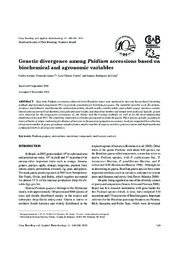Genetic divergence among Psidium accessions based on biochemical and agronomic variables.
Genetic divergence among Psidium accessions based on biochemical and agronomic variables.
Author(s): SANTOS, C. A. F.; CORRÊA, L. C.; COSTA, S. R. da
Summary: Sixty-nine Psidium accessions collected in six Brazilian states were analyzed by two non-hierarchical clustering methods and principal components (PC), to provide orientation for breeding programs. The variables ascorbic acid, ?-carotene, lycopene, total phenols, total flavonoids, antioxidant activity, titrable acidity, soluble solids, total soluble sugars, moisture content, lateral and transversal fruit diameter, fruit pulp and seed weighs, and plant fruit number and weight were analyzed. Specific groups were observed for the araçazeiros accessions, by the Tocher and the k-means methods, as well as by the three-dimensional dispersion of the four PCs. The clustering separated accessions of araçazeiros from the guava. There was no specific grouping in nterms of States of origin, indicating the absence of barriers in the guava propagation accessions. Analyses suggested the collection of a greater number of guava germplasm samples from a smaller number of regions and divergent accessions with high nutritional compound levels to develop new cultivars
Publication year: 2011
Types of publication: Journal article
Unit: Embrapa Semi-arid Region
Observation
Some of Embrapa's publications are published as ePub files. To read them, use or download one of the following free software options to your computer or mobile device. Android: Google Play Books; IOS: iBooks; Windows and Linux: Calibre.
Access other publications
Access the Agricultural Research Database (BDPA) to consult Embrapa's full library collection and records.
Visit Embrapa Bookstore to purchase books and other publications sold by Embrapa.

